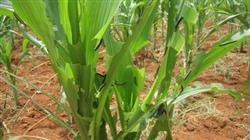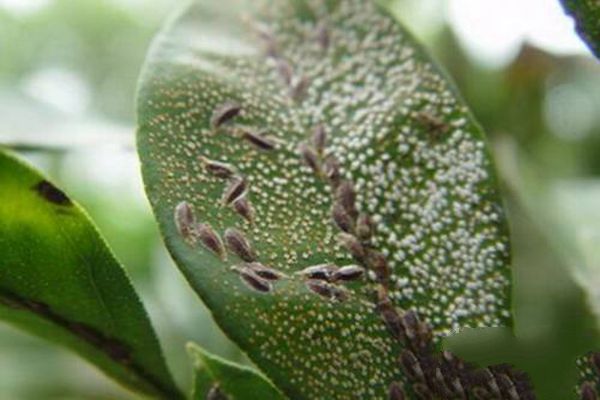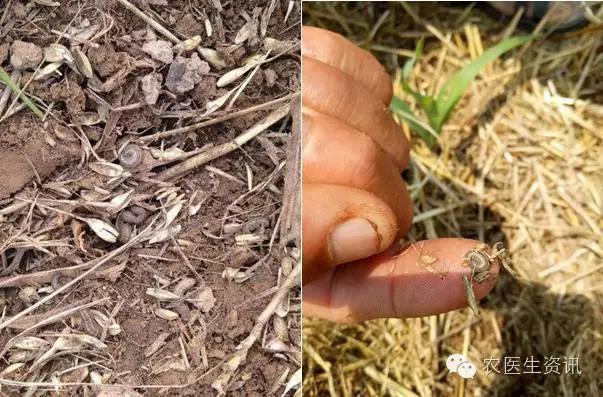oviposition Learn more about oviposition
-
How to manage the oviposition of adult Tenebrio Molitor

How to manage the oviposition of adult Tenebrio Molitor
2019-02-06 -
Rice green planthopper

The scientific name is Homoptera, Homoptera. Distributed in the south and north of Zizania caduciflora and rice growing areas. Host rice, Zizania caduciflora, wild Zizania caduciflora, etc. The damage is characterized by nymphs sucking rice juice, and the injured leaves appear yellow-white to light brown or brown spots, and then the leaves gradually turn yellow and dry from the leaf tip to the base, the feces cover the leaves to form coal stains, and the female oviposition marks show water stains at the beginning, then secrete white velvet wax powder, lose water after the wound, and the plants wither and die in patches. Morphological characteristics of male adult body length 5-6.1mm
2019-01-16 -
How to control taro locust in rice

The scientific name Gesonulapunctifrons (Stdl) belongs to Orthoptera, Acridoidea. Distributed in Jiangsu, Zhejiang, Jiangxi, Fujian, Guangdong, Guangxi, Taiwan, Sichuan, Yunnan and other provinces and regions. Host rice, taro, lotus root, wild daffodils, sugarcane, corn and other plants. The damage was characterized by adults and nymphs gnawing on leaves or leaving epidermis on mesophyll, and the injured leaves showed purple small horizontal spots, which affected photosynthesis and hindered plant growth. Morphological characteristics female adults grow 19-22mm, male adults
2019-01-16 -
Common corn insect pests and diseases

Common corn insect pests and diseases
2019-03-03 -
How to control the corn armyworm?

How to control the corn armyworm? What is the corn armyworm? What kind of pesticide does corn armyworm hit with? The corn armyworm, also known as the five-color worm, has miscellaneous food habits. The adults lie dormant during the day and come out at night. Most of them lay eggs in the withered and yellow leaf tips and leaf sheaths of the middle and lower parts of wheat. A single female lays 1000 / 2000 eggs. The larvae are mostly active in the morning and evening, that is, in the morning.
2018-07-17 -
How much is the price of 2019 forest frogs per jin? What is the method of building the spawning pool of Rana chensinensis?

Chinese forest frog is an amphibian family, frog genus, commonly known as the toad, is a kind of high economic value of food and medicine as one of the precious amphibians. Next, let's introduce how much the forest frog costs per jin and how to build the spawning pool of the Chinese forest frog.
2020-11-11 2019 forest frog price more less money one jin China spawning pond -
Control of citrus fruit fly

[morphological characteristics] the adult is 6-8 mm long, with a wingspan of 16 mm, all dark black and yellow. There are 11 pairs of bristles in the chest, most of which are yellowish brown, including 2 pairs of shoulder plate bristles, 2 pairs of dorsal bristles, 1 pair of anterior wing bristles, 2 pairs of posterior wing bristles, 1 pair of medial plate bristles, 1 pair of wing lateral bristles and small shield.
2020-11-08 Species citrus small fruit fly control morphological characteristics adult body length -
Are giant arboreal or aquatic snakes viviparous or oviparous?

In people's common sense, snakes lay eggs because they lay eggs. in fact, snakes reproduce in two ways: egg laying and egg birth. So are giant arboreal or aquatic snake pythons viviparous or oviparous? According to the data, oviposition is direct oviposition and oviparity.
2020-11-11 Giant large arboreal sexual or aquatic snake python yes viviparous -
How do shellfish reproduce?

Shellfish generally refers to oysters, mussels, clams, snails and other animals, a wide variety of species, widely distributed. The way of reproduction is also different, so how do shellfish reproduce? First, how to reproduce shellfish? The way shellfish reproduce varies from species to species. Such as direct spawning and mating
2020-11-11 Shellfish how breeding shellfish generally refers to oysters mussels clams -
The habits of longicorn beetles

Longicorn beetles have long tentacles. Before seeing them, many friends thought they were the same animals as cattle. In fact, longicorn beetles are insects and very small. So do you know the habits of longicorn beetles? Let's have a look together! Habits of longicorn beetles in larval stage
2020-11-11 Longicorn beetles habits longicorn beetles long antennae many friends. -
Control of Buxus inchworm

Occurrence regularity: the larva eats leaves and occurs for three generations in Hunan. The overwintering adults Eclosion and oviposition in mid-April, then pupation in late April, Eclosion in mid-June, second generation damage in late June, pupation in early August, Eclosion in mid-August, damage to the third generation in late August. The worst victims are the first and second generations. The damage is the most serious in the mild climate and abundant rainfall season, which can gnaw off the leaves of the whole plant in 2 to 3 days, making the plant bald. In
2019-01-11 -
Control of jujube gall midge

Also known as jujube bud maggot, damage jujube tree buds and young leaves. This insect occurs early, has many generations and has a long damage period. it has a great influence on the development of seedlings, young trees and the fruiting of adult trees. it is one of the main leaf pests of jujube trees. The insect has 5 Mel 7 generations a year in North China, overwintering with mature larvae forming cocoons in the soil, adults Eclosion and oviposition in April next year, and the first ten days of May is the peak period of damage. Control methods: 1. Spray the ground with 1000 times of trichlorfon powder or 25% phoxim, combined with turning the garden to eliminate overwintering.
2019-01-16 -
Main damage modes of flower pests

Main damage modes of flower pests
2019-10-22 -
The two-point nocturnal moth has appeared! Summer corn growers should be careful!

The two-point nocturnal moth has appeared! Summer corn growers should be careful!
2019-02-20 -
Fenvalerate method

At night, spray fenvalerate evenly in the ditch, then bury the cage on the bank, and the next morning you can catch the crayfish that crawl into the cage and pass out. Although this method can catch shrimp, it is very toxic to crayfish and will be direct.
2020-11-11 Cyanoamyl permethrin prawn method at night sometimes cyanoamyl -
Occurrence characteristics and control of garlic maggot

First, harmful symptoms garlic maggots eat garlic bulbs with larvae, so that the bulbs rot, the aboveground leaves wither, wilt, and even die. The maggot pupa can be found when the injured plant is pulled out, the damaged garlic skin is yellowish brown rotten, the garlic head is drilled into a hole by the larvae, incomplete, and the garlic cloves are exposed and cracked, accompanied by a foul smell. The injured plant is easy to be pulled out and cut off. Second, the occurrence characteristics of garlic maggots can cause harm before winter. after entering winter, they pupate and overwinter, and begin to Eclosion from pupae to adults in March of the following year. Adults lay eggs around garlic roots.
2019-01-15 -
Occurrence and control of pear gibberella

The adult began to Eclosion in late April and bit a flat round hole in the first and middle of May. The adults feed on the leaves during the day after coming out of the hole, and lie still on the leaves sooner or later, and have the habit of falling to the ground and false death. The adult began to lay eggs in about 10 days after coming out of the hole, and the trunk crawled at the front of the oviposition. The ovipositor was inserted into the rough and warped gap of the bark to lay eggs. Most of the eggs were laid in the branches of more than 2 years old, 3 eggs were laid in one place, and each female could lay 40 eggs. The peak spawning period is in mid-late May and the peak incubation period is in early June. The hatched larvae first eat into the cortex.
2019-01-15 -
Feeding and management of Tenebrio Molitor in different growth stages

Feeding and management of Tenebrio Molitor: 1) all tools should be cleaned and disinfected with 0.1% potassium permanganate solution before the preparation work begins. The feeding room sprayed 2% Lysol solution to disinfect the floor, and then used bactericidal disinfectant spray to disinfect the space. Feeding plate
2020-11-08 Culture Tenebrio Molitor different growth stage breeding Management -
How to control armyworm in Northeast China?

How to control armyworm in Northeast China? Please introduce that the source of armyworm in Northeast China mainly comes from the Yangtze-Huaihe River Basin. After the emergence of the first generation of adults in this area, it usually migrates into Northeast China from late May to mid-June to lay eggs. The second generation of larvae appeared in the field in the first and middle of June.
2018-07-14 -
Harvesting and processing methods of Trionyx sinensis

In zoology, the soft-shelled turtle belongs to the insects of Insecta, winged subclass and Blattella. There are many kinds of soft-shelled turtles. According to the literature records, there are Chinese soft-shelled turtle, Hebei soft-shelled turtle, Xizang soft-shelled turtle, Yunnan soft-shelled turtle and Phnom Penh soft-shelled turtle. At present, the main artificial breeding is the Chinese soft-shelled turtle, Hebei soft-shelled turtle. Trionyx sinensis is a traditional Chinese medicine. The first edition of Shennong Materia Medica Sutra: "Cold and hot washing of the main heart, hematocele, broken firmness, lower blood blockage". The Compendium of Materia Medica records: "Postpartum hematocele, bruise and blood stasis, treatment of severe tongue, mouth sores, and children's abdominal pain cry at night." "classified herbal medicine
2019-01-16
